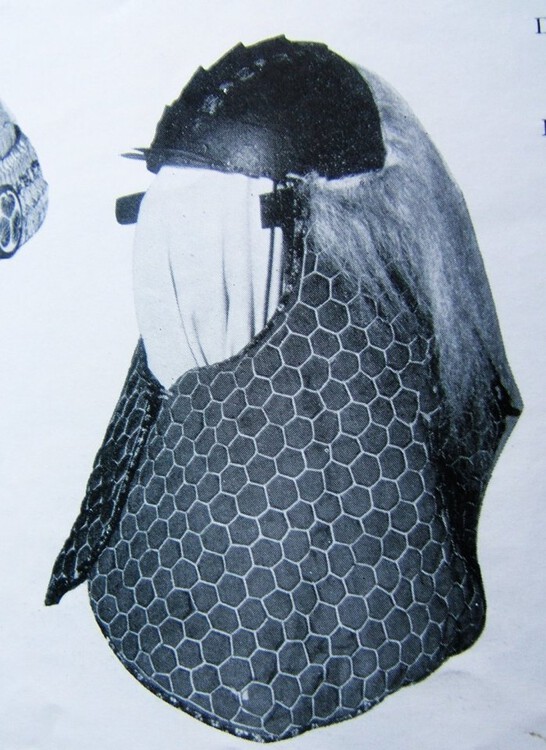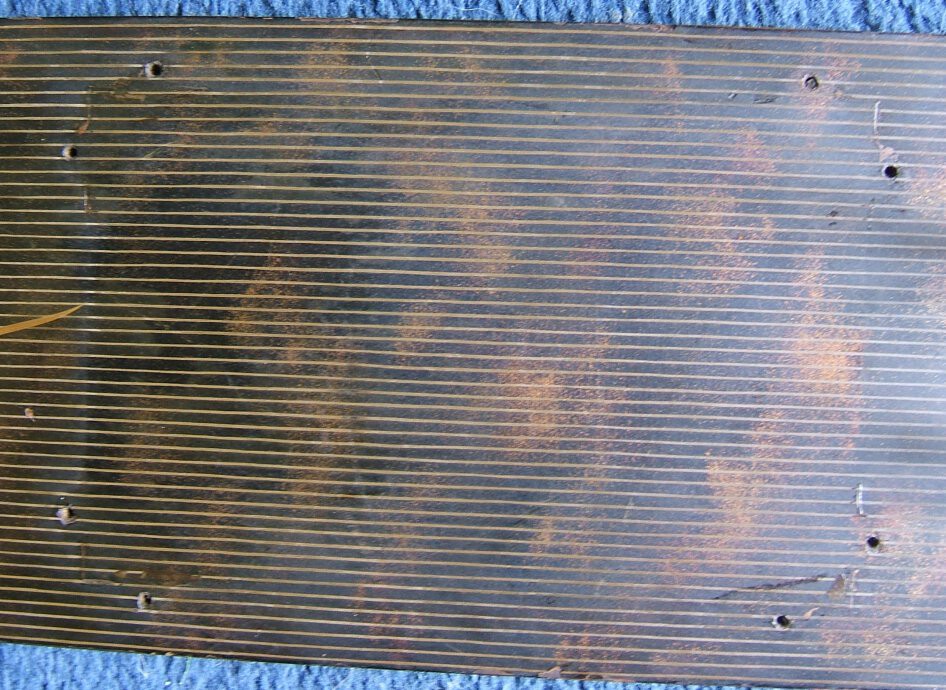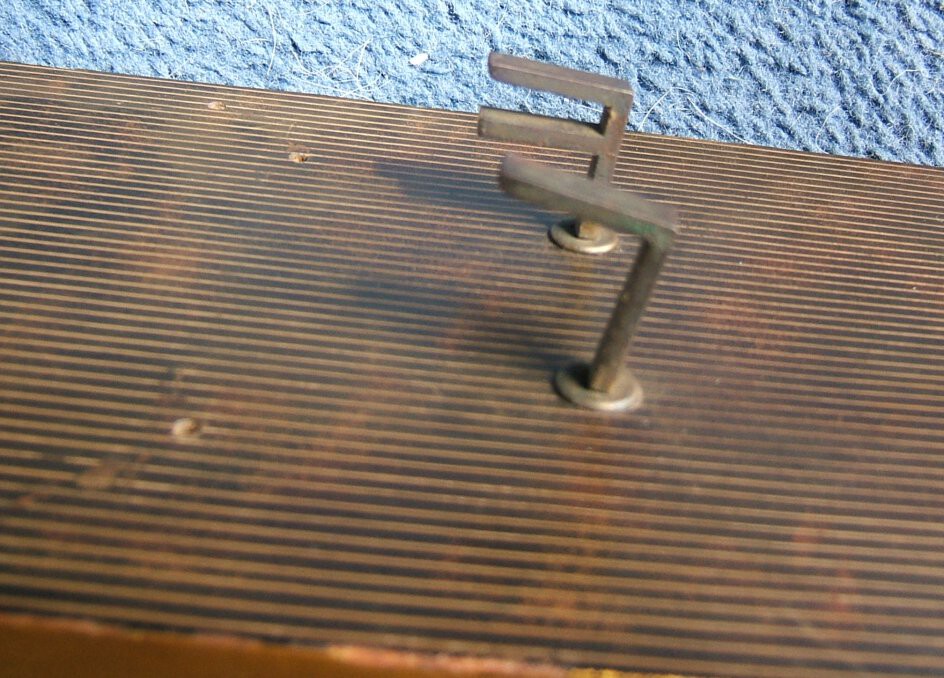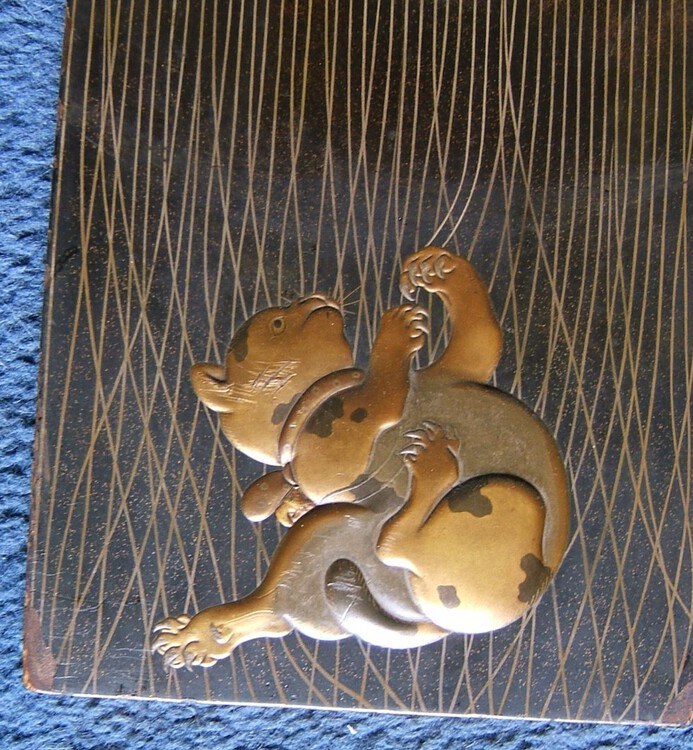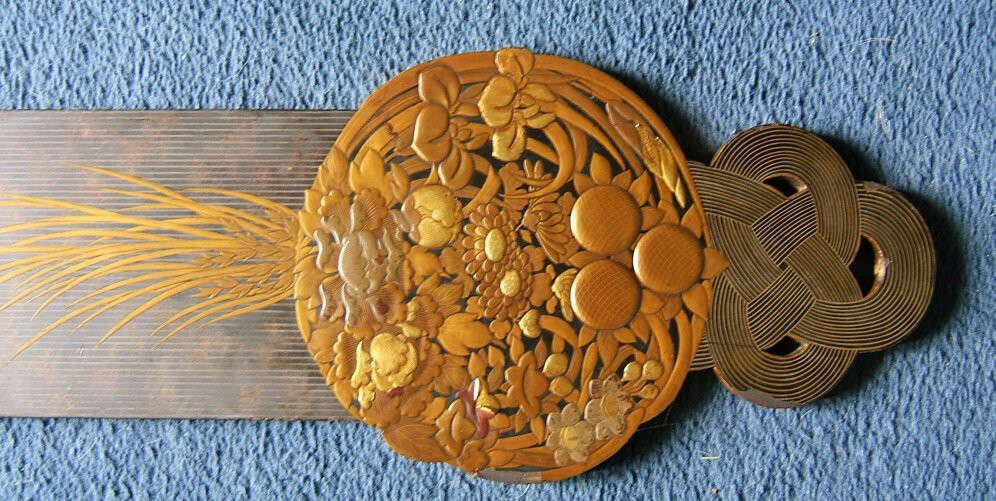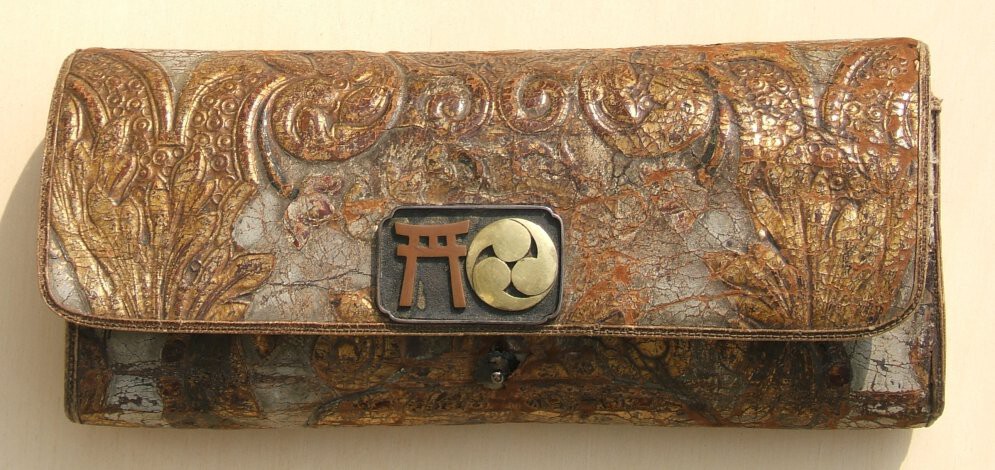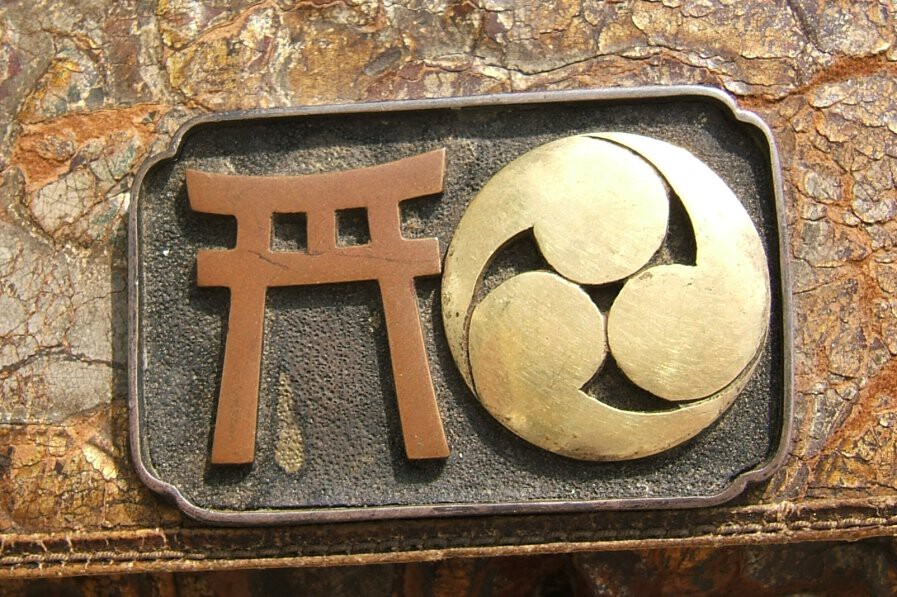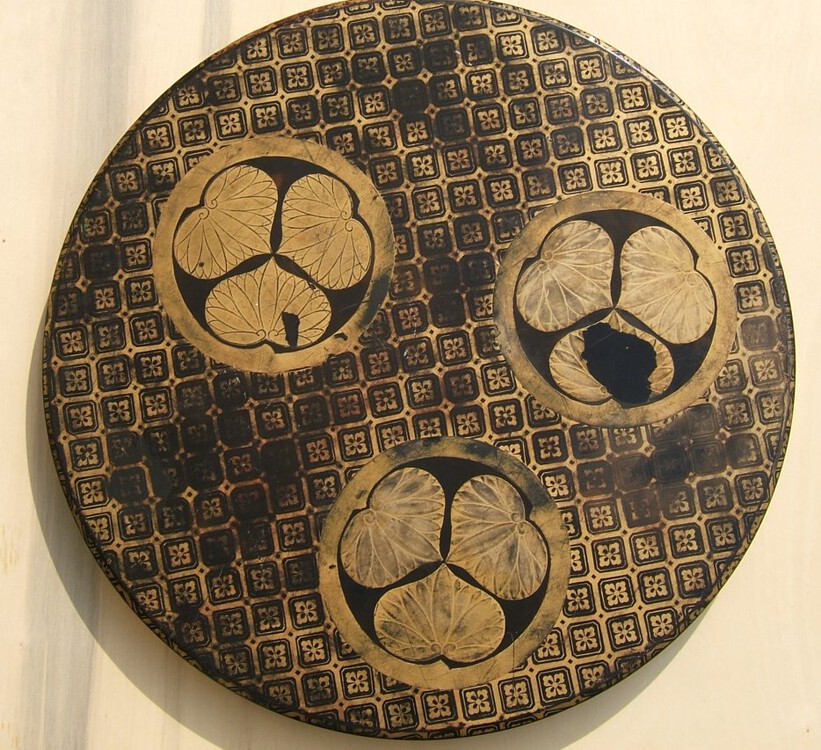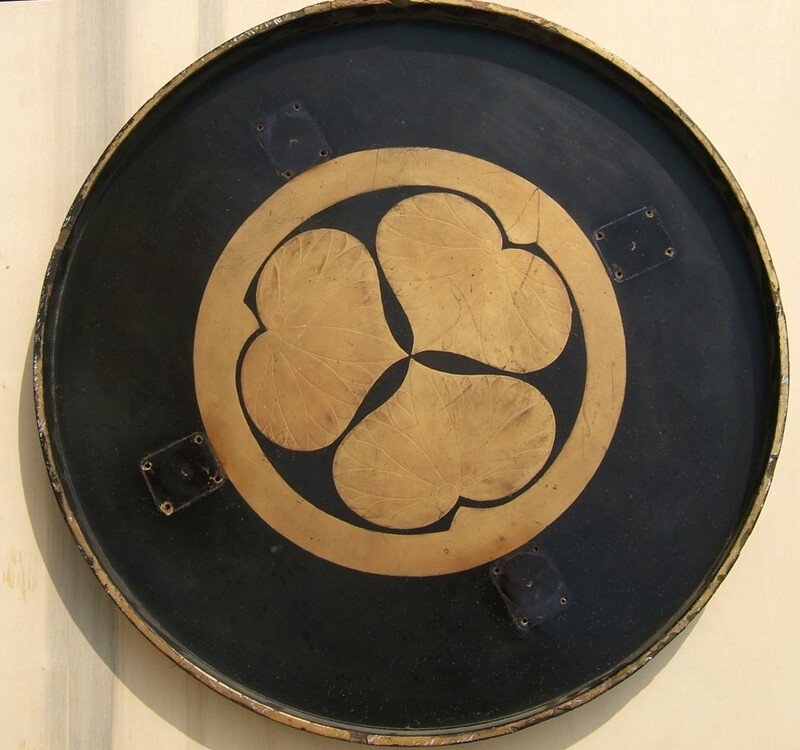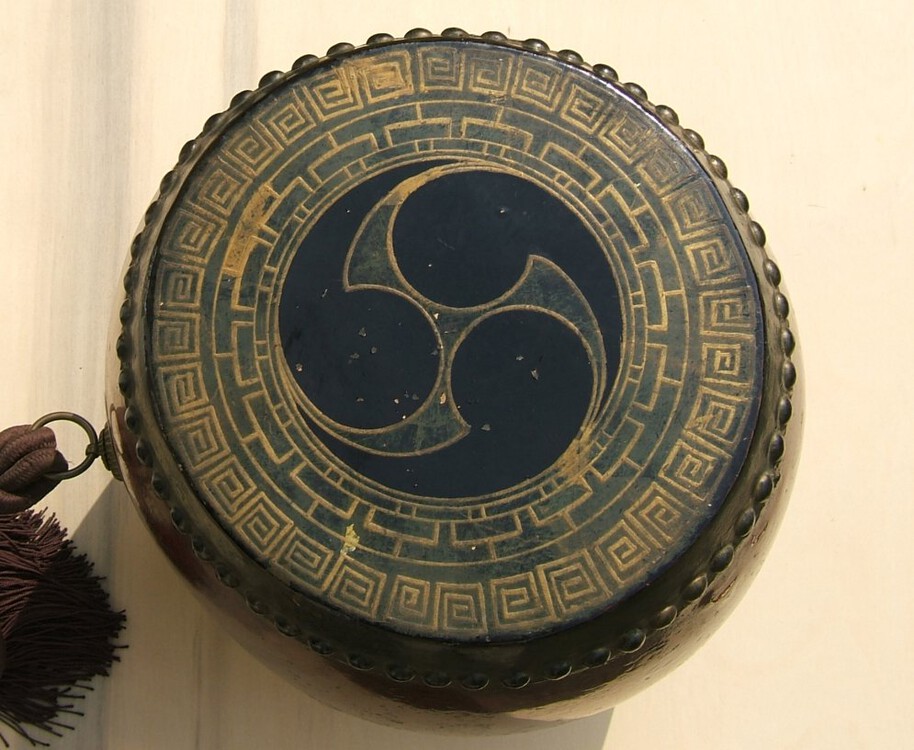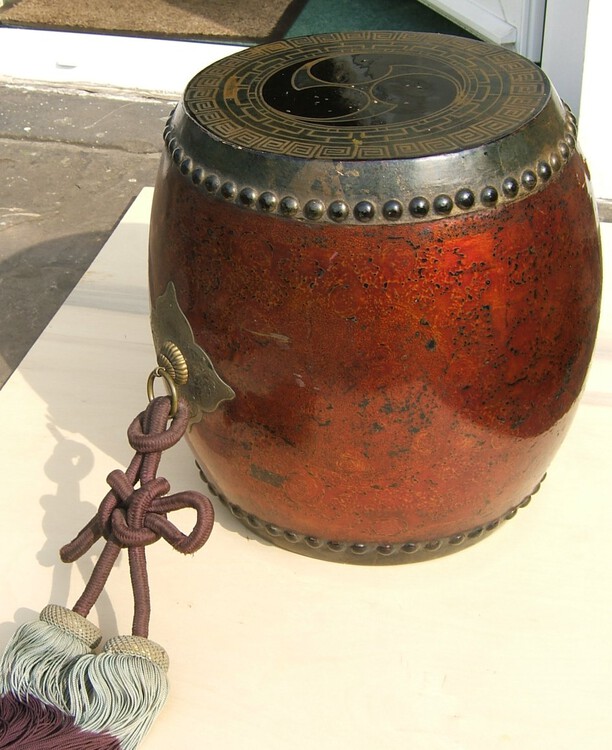
IanB
Members-
Posts
1,778 -
Joined
-
Last visited
-
Days Won
23
Everything posted by IanB
-
This Week's Edo Period Corner
IanB replied to Bugyotsuji's topic in General Nihonto Related Discussion
Piers, I think this B/W image is the only time the object has been published. It has certainly not been exhibited whilst it has been in Leeds. I had remembered the hood somewhat wrongly - it left more of the face exposed. Also, the arms carrying the hinged fukigayeshi cannot swing down because of the hair and hood. Ian -
This Week's Edo Period Corner
IanB replied to Bugyotsuji's topic in General Nihonto Related Discussion
Piers, Your new helmet sounds like one in the Royal Armouries. It was really a hitae ate of, if I remember correctly, three main plates from the brow to the top of the head, each of which was divided vertically by a hinge. The front plate had two little hinged flaps that formed a divided mabezashi and the tiny fukigayeshi, again hinged, were attached to iron strips that pivoted on the same rivet that held the three main plates together. All the metalwork was russet. What is nice about the RA one is that it still has a kind of hood, of kikko, attached. This was in three parts, of pale green hemp with white thread sewing to outline the plates inside. There was a triangular panel centred on the top plate that reached down to the nape of the neck with two side pieces that hung down onto the shoulders and buttoned in front over the face leaving only the eyes exposed. The three kikko panels were laced together like the inside of a kote with thin silk cord. Where the kikko joined the plates, over the head from ear to ear, was attached a long fringe of yak hair that covered most of the kikko. A very nice item of a type I have never seen before, but sounding exactly like yours. I have a more simple one of three pivoting plates with rather large ear flaps like a Roman helmet. There is no hood, just a hemp tie that holds it on the head. I also have an odd mail hood, of the usual type that drapes over the shoulders and fastens over the face, but which has a vertical leather peak with a gilded kamon and a section of deer antler on each temple. Attached to the rear end of the antler bits is a stout hemp cord covered in lacquered leather that pulls down into the nape of the neck when wearing it - which seems to hold it on. Ian Bottomley -
This Week's Edo Period Corner
IanB replied to Bugyotsuji's topic in General Nihonto Related Discussion
Piers, Yes, the hooks are complete and designed that way - one single, one double. At the back, the ends of the hooks are hidden by domed, silvered brass covers. What didn't come out in the pics is the fact that the front surface is indented slightly by the corners of whatever was attached - the indentations being thin lines showing it was in the form of a sheet metal box. The whole style says Meiji period to me so all manner of things, including a barometer, could have been attached. I'm sure it is domestic and the hooks are clearly meant to carry something reasonably heavy. Ian -
John, Might I suggest kiyo? Sorry but I dont know how to insert kanji but it is 295 in Nelson's dictionary. Ian
-
This Week's Edo Period Corner
IanB replied to Bugyotsuji's topic in General Nihonto Related Discussion
All, It is about time to introduce you to something different and get things moving in this area. The object in question is a bit of a mystery. I bought it from an antique dealer about 20 years ago and he didn't know what it was and neither do I. However, its a fabulous object and I would appreciate opinions. It consists of a lacquered panel, about 45 inches long, the major part being about 6 inches wide. At the top it is shaped as a formal knot with long strings, done in gold lacquer on a sparse nashiji, that hang down to the base. Marks indicate that the upper hole has been used to hang it. Below the knot is a roundle decorated with flowers of the four seasons in lacquer and gold foil. The three chrysanthemum flowers are obviously a kamon, and may be from one of the many Watanabe families. Below the flowers are ears and leaves of rice. At the base is a delightfully rendered cat in slight relief playing with and tangling the hanging strings. All this is obviously symbolic and festival - like. Now comes the interesting bit. Above the cat are two hooks in silvered brass, one having a curious double hook arrangement. Above them are pairs of holes that outline an area of 7.5" x 5" that have clearly held something to the board. My guess is that it is the backing for a clock, the hooks being to hang the weights on when it is being moved, but I stand to be corrected. Ian Bottomley -
Steve, I'm afraid Paul is quite correct. When the Royal Armouries decided to move its main base out of the Tower, mainly for reasons of space, all of the Oriental collection was transferred. The only item left in the Tower is one of the two armours given to King James I by Tokugawa Ieyasu. It is by Iwai Yosaemon of Nara and I have managed to show that it was made for Takeda Katsuyori. Sadly, over the centuries it became very dilapidated and was sent to Japan for restoration in the 1970's. Much of what you remember from the Tower display were items from a gift to Queen Victoria by the last Shogun. This gift was divided up between the Royal Armouries, the V&A and the Royal Collection at Windsor Castle. Quite a bit of it is displayed at Leeds including a complete horse harness, yari, one of the naginata and a few minor pieces. The Royal Armouries in fact received only a small amount of material from this gift. Some other material in that old display at the Tower was on loan from the National Trust and waas returned to them during the move. As Paul says, there are still some swords displayed at the V&A as well as the British Museum, but only a tiny proportion of what they hold. The Wallace collection contains only a tachi / tanto daisho, but of wonderful quality. Other than that I'm afraid it is the dealers. Ian Bottomley
-
This Week's Edo Period Corner
IanB replied to Bugyotsuji's topic in General Nihonto Related Discussion
Piers You will have bread and jam like the rest of us. Ian -
This Week's Edo Period Corner
IanB replied to Bugyotsuji's topic in General Nihonto Related Discussion
Piers, Good question. It does make sense insofar as the katana scabbard is not in contact with the do with the consequent potential damage to the lacquer. Of course the higher ranks wore tachi anyway so they didn't have that problem. If you are calling in at the Royal Armouries, let me know in advance and we can meet up for lunch. Ian -
This Week's Edo Period Corner
IanB replied to Bugyotsuji's topic in General Nihonto Related Discussion
Piers, The use of the term renkon seems quite reasonable if used for the seedpod of the lotus. A loaded cylinder of a revolver looks exactly like that. The use of guns that employed detonating pills must have been fairly short lived since they were quickly replaced by Japanese copies of box-lock pistols based on European / American models. Again the Royal Armouries has a couple, both with the box and barrel cast in brass as a unit and fitted with swivle ramrods. Once percussion caps became available you then get essentially the same box-lock mechanism used for guns disguised as tanto. However, there is one of these in the RA that used detonating pills. I never had chance to strip it down, but within the hilt was a longitudinal spring loaded plunger that terminated in a ring sticking out of the kashira. This you pulled to cock it and it was released by a button pretending to be the end of the mekugi. There was a hole in the hilt, just above the fuchi in which I assume you dropped a detonating pellet. Elegant it wasn't and the ring sticking out of the end rather spoiled the 'concealed gun' idea, but it must have worked. On the subject of imported guns, the Pitt-Rivers Museum in Oxford has / had a nice iron framed Winchester with the frame chiselled with a hare and waves - no doubt given to some daimyo as a present. Bill Galeno of California used to have a relatively ordinary looking teppo but fitted with a snider breech mechanism. It wasn't a conversion so I assume it was made for some traditionalist when self-contained cartridges became available. Ian B -
This Week's Edo Period Corner
IanB replied to Bugyotsuji's topic in General Nihonto Related Discussion
Brian, The karashi ju were simple, usually bronze barrels without a stock. On top was a depression in the base of which was the touch hole. Hinged to the breech end of the barrel was a forward pointing lever having a small projection that fitted into the depression. The idea was that you loaded the barrel in the normal way and placed a detonating pill in the depression (there was usually a little pivoted flap that covered the pill until you were ready to fire). To shoot the gun you simply squeezed the lever against the barrel, the projection crushing the pill and exploding it. They must have been rather dodgy to use since there was nothing to stop the flame burning your hand. Ian Bottomley -
This Week's Edo Period Corner
IanB replied to Bugyotsuji's topic in General Nihonto Related Discussion
Piers, Yes I am familiar with them. They were an interim development that followed the invention of the percussion system by the Rev. Alexander Forsyth. His guns used loose detonating powder held in a magazine that deposited a tiny amount on a nipple to be struck by the hammer. His locks worked well but were complex and expensive. A cheaper alternative was to use the detonating substance formed into small pills or pellets that could be either manually positioned on the nipple, or enclosed between strips or patches of paper like those for a toy cap gun. All manner of systems were patented using different ways of enabling the detonating compound to be handled without blowing your fingers off. Ultimately all these ideas were replaced by the copper cap that was safe to handle, weather-proof and so on. When the Americans landed, the Japanese, not having access to copper caps, took up the idea of the pills and made the relatively simple karashi ju, or mustard-seed guns that you describe (the pills reminding the Japanese of the seeds). One of the pioneers was Katai Kyosuke who not only made the pellets but also devised a self-priming carbine to use with them. I managed to acquire one of these guns for the Royal Armouries. It was essentially like a conventional matchlock but was fitted with a sliding ring for a shoulder sling, a captive ramrod and an iron lock having a hammer rather than a regular serpentine. On top of the pan was a hinged sprung flap through which passed a plunger that was hit by the hammer. The lock also had a thumb-piece that allowed you to cock the hammer by pressing it down. In front of the pan was a long brass square-sectioned tubular magazine whose forward part could be pressed inwards against a spring. The gun was operated by cocking the hammer then pressing the end of the brass magazine. As it moved rearward it lifted the flap over the pan and deposited a percussion pill into the pan. On releasing the magazine slider, the flap over the pan dropped back, trapping the pill under the plunger which when hit by the hammer fired the gun. The gun was beautifully made but I never got into the magazine to see how it was loaded and how it worked. Ian Bottomley -
What an interesting thread. What is the patination of shakudo, or the gilding of copper, if its not chemistry? These artist / craftsmen used chemistry all the time to achieve the effect they wanted; including the use of mixtures that might included reagents from organic sources. They would have used four week old marmalade sandwiches if it produced the effect they wanted. As I understand the technique being described, the artist engraves the base and then fills the grooves with mercury / gold amalgam. After driving off the mercury, the then partially filled groove is topped up again and the process repeated until the gold is flush with the surface of the ground. He then etches back the ground to leave the gold slightly proud. How clever and how laborious. As for the horses, remember that the Tensho mission to Europe brought horses from India to improve the native stock and that Tokugawa Yoshimune asked for, and received, five western horses from the VOC to improve the Japanese stock. The resulting hybrids may well have been a little oddly shaped until the program had achieved its full potential. Ian Bottomley
-
Ian, Do all you can to retain the original components of your sword. The hilt, scabbard and fittings may well have been chosen by someone who owned the blade and should be kept with it. There is however another possibility why it has such an assortment. During the early years of the Meiji restoration swords and armours were abundant and dealers were flooded with them. I used to have a book written by the Bishop of Durham (who visited to set up a missionary school) who comments that he bought dozens of fine pieces at what he regarded ridiculous prices. This supply soon dried up however and dealers had to scratch around to supply the tourist trade. One of their tricks was to buy up sword parts and assemble them into suitable swords and armour for trade - the tourists didn't know or care and there were plenty of craftsmen still around to refurbish the parts and assemble the bits. You often see eclectic assemblies of mis-matched fuchi kashira, menuki and so forth on swords with original bindings. Some may be Edo period, belonging to poor samurai who couldn't afford better, but I'm sure most were knocked up by dealers to make a yen or two. Ian Bottomley
-
All, I see no evidence whatsoever of casting. There is no evidence of flashing on any of the edges, no sign of shrinking of the metal on the flat surfaces of the seppa dai and there is a copper sekigane at the upper end of the nakago ana. Yes it is big and heavy and has been rather corroded during its life. It may have been designed to balance a sword by bringing the weight more towards the hilt. As for the design, it looks to me like a kamon. And yes, after getting off my backside and looking I have found the kamon in my 'Every Boys handy pocket book of Kamon' (in reality Eiyu tachi no Kamon)), it is of two holly leaves (hiiragi). Unfortunately the book simply states that it represents the outside of each leaf and does not mention the family. Ian Bottomley
-
Dick, The whole of this sorry and pathetic situation is the result of that guardian of justice, our rights and safety, the BBC's programme 'Watchdog'. They, shock, horror, managed to buy dangerous combat knives on eBay and hauled the UK eBay manager over the coals for their total irresponsibility in allowing them to fall into the hands of toddlers. Since you could buy equally, or even more, lethal knives in any kitchen shop in the UK it smacked of sensational journalism. A few trial bids on the international eBay site suggests that it is not the description keywords that matter but the category. It is the sword, knife, edged weapon categories that trigger the ban. No doubt the population of the UK will be forced into using only plastic scissors before long. Ian Bottomley
-
This Week's Edo Period Corner
IanB replied to Bugyotsuji's topic in General Nihonto Related Discussion
Carlo, Lorenzo, It is a kago hankyu or Riman kyu, so-called since it was invented by Hayashi Riman. The bows are almost always of baleen. What I found odd was the large and exotic shape of the carrying frame. They are usually much smaller and compact - there wasn't much room in a kago. Ian -
This Week's Edo Period Corner
IanB replied to Bugyotsuji's topic in General Nihonto Related Discussion
Carlo, Thank you for that. A very strange set. Ian -
Like John I have tried with rather doubtful results. I did manage to make sense of a page from an armour book in which the author reported visiting a shrine and discovering an old pair of sode. With sword and armour books in general the software just falls over when it comes to technical terms. What did impress me was that the OCR software did read a lot of the kanji, even when it was not exactly aligned in the scanner. What was a failure was the next stage where the scanned kanji had to be corrected before conversion to a text file. It took almost as much time looking up and correcting than it would have done to do the whole thing manually. The final stage then converts the text file into English - or rather tries to. All in all it has a long way to go before it is really useful. Ian Bottomley
-
Fujiwara Kunitsuna Katana
IanB replied to YukouYukimura's topic in Auctions and Online Sales or Sellers
Tyler, I agree with Paul that this sword has seen a great deal of abuse. I doubt the horimono ever looked good, and what remains is sad indeed. On the plus side, and yes I can see some, is the fact that the habaki is covered with silver foil and the seppa with what looks like gold foil (or at least silver gilt). These features cost the owner money when the sword was mounted. Someone thought a lot about it. I am also intrigued by the tsuba, badly worn as it is. I assume it represents Hotei with his sack. On the back I can see the kanji for 'genuine', 'excellent' and 'iron'. Rather curious. If you do choose to buy, it will never look great but there just may be some redeeming features awaiting discovery. Ian -
This Week's Edo Period Corner
IanB replied to Bugyotsuji's topic in General Nihonto Related Discussion
Piers, Despite the name the leather is in fact Dutch. Years ago I was walking around the Rijkes Museum in Amsterdam and came across a wall covered in the stuff. Even more interesting was that it was the exact pattern of leather as on the front of an armour of mine. After a chat with the leather curator, he took me up to his office / studio in the rafters of the building and there was the original wooden mould that design was made in. The process involved pressing wet sheepskins into the mould. When dry, selected parts were covered with tin foil and then coated with orange coloured varnish so that it looked gilded. The rest was then painted with oil based paints. When stretched on a frame, like a painting, it was used in place of wood panelling. It was also used for furniture and the like. Ian -
This Week's Edo Period Corner
IanB replied to Bugyotsuji's topic in General Nihonto Related Discussion
John, No you are right. There are no holes in the edge for suspension of the pouch. It is also much bigger than the sagemono pouches. My guess is that it is for carrying documents, tucked into the kimono. Ian -
This Week's Edo Period Corner
IanB replied to Bugyotsuji's topic in General Nihonto Related Discussion
All, On a completely new tack is something I have treasured for about 20 years. I bought it from a great guy who used to run a Japanese antiques shop in San Francisco. Its made of Dutch leather, which was shipped to Nagasaki in the 18th century, but could be a bit older. When it was made into the pouch I do not know but it is now a bit fragile. The clasp is what got to me. The two kamon made me think it might be a wedding thing but I'm not sure. Ian -
This Week's Edo Period Corner
IanB replied to Bugyotsuji's topic in General Nihonto Related Discussion
Piers, As promised the images of my drum. The tassel was picked up in a flea market in Tokyo for the princely sum of 500 yen. I also include the pictures of the wash-tub lid. It must have been fabulous in its day but is now a sad relic. Ian Bottomley -
This Week's Edo Period Corner
IanB replied to Bugyotsuji's topic in General Nihonto Related Discussion
Piers, its getting dark here now so I will take some pics over the week-end. Ian -
This Week's Edo Period Corner
IanB replied to Bugyotsuji's topic in General Nihonto Related Discussion
Piers, I think a lot have the mitsu tomoe on at least one skin. I have one, about 20" diameter with the whole body done gold swirly lacquer. I found it in a junk shop and had been used as a small coffee table judging by the ring stains. It has something inside that rattles about when you move it. Also found as a coffee table, this time with legs screwed on, is a large lid for a wash basin. It is about 3' diameter with Tokugawa kamon and karakusa in gold. Inside is a massive Tokugawa kamon in gold foil, some of which is now missing. Its in a bad state, but for £1 you can't grumble too much. Ian Bottomley

